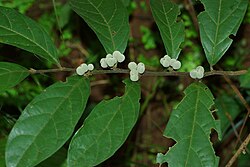| Dichapetalum gelonioides | |
|---|---|
 | |
| Scientific classification | |
| Kingdom: | Plantae |
| Clade: | Tracheophytes |
| Clade: | Angiosperms |
| Clade: | Eudicots |
| Clade: | Rosids |
| Order: | Malpighiales |
| Family: | Dichapetalaceae |
| Genus: | Dichapetalum |
| Species: | D. gelonioides |
| Binomial name | |
| Dichapetalum gelonioides (Roxb.) Engl. | |
| Synonyms [2] | |
| |
Dichapetalum gelonioides, the gelonium poison-leaf, [3] is a large shrub or small semi-evergreen tree, up to 5 m tall, originally described from Indo-Malaysian region. [4] [5]
